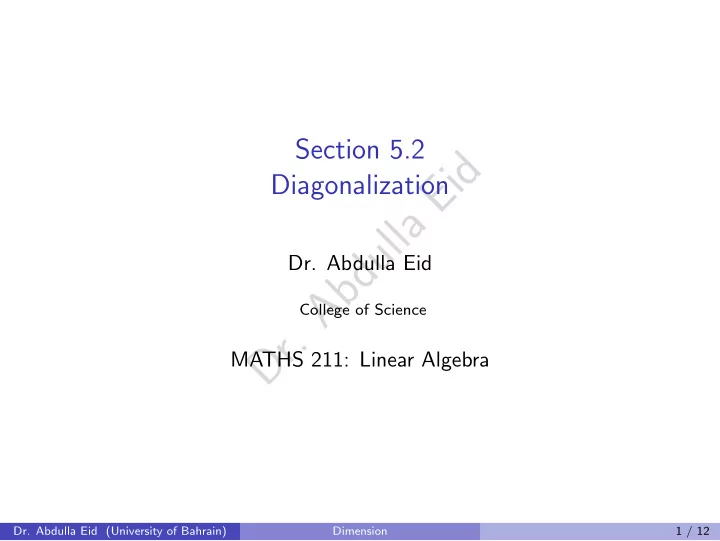

Section 5.2 d i E Diagonalization a l l u d Dr. Abdulla Eid b A College of Science . r D MATHS 211: Linear Algebra Dr. Abdulla Eid (University of Bahrain) Dimension 1 / 12
d Goal: i E 1 Finding diagonalization of a matrix. a l 2 When has a matrix A , a diagonalization? l u d 3 Benefits of diagonalization of a matrix. b A . r D Dr. Abdulla Eid (University of Bahrain) Dimension 2 / 12
Definition 1 d i If A is an n × n matrix, then a nonzero vector x in R n is called an E Eigenvector of A if a l l A x = λ x u d b for some scalar λ ∈ R . The scalar λ is an Eigenvalue of A and x is said A to be the Eigenvector corresponding to λ . . r D Dr. Abdulla Eid (University of Bahrain) Dimension 3 / 12
Characteristic Polynomial of a matrix d i E Theorem 2 a If A is an n × n matrix, then λ is an Eigenvalue if and only if l l u d det ( λ I n − A ) = 0 b A This is called the characteristic polynomial of A. . r D Dr. Abdulla Eid (University of Bahrain) Dimension 4 / 12
Example 3 Find the Diagonalization of � 2 � − 1 A = d 10 − 9 i E a l l u d b A . r D Dr. Abdulla Eid (University of Bahrain) Dimension 5 / 12
Example 4 Write the following matrix � 3 � 0 A = 5 3 d i as A = PDP − 1 , for some matrix P and diagonal matrix D . E a Questions: How can we do that? l l u When that can happen? d b Why would you that in the first place? A . r D Dr. Abdulla Eid (University of Bahrain) Dimension 6 / 12
Example 5 Write the following matrix − 2 0 0 A = 0 1 1 d 0 1 1 i E as A = PDP − 1 , for some matrix P and diagonal matrix D . a l l u Questions: How can we do that? d b When that can happen? A Why would you that in the first place? . r D Dr. Abdulla Eid (University of Bahrain) Dimension 7 / 12
Example 6 Write the following matrix 1 0 0 A = 2 3 0 d 0 1 3 i E as A = PDP − 1 , for some matrix P and diagonal matrix D . a l l u Questions: How can we do that? d b When that can happen? A Why would you that in the first place? . r D Dr. Abdulla Eid (University of Bahrain) Dimension 8 / 12
When can we diagonalize a matrix? Theorem 7 A is diagonalizable if and only if A has exactly n linearly independent Eigenvectors. d i E a l l u d b A . r D A shortcut (sometimes is useful) Theorem 8 If A has n distinct Eigenvalues, then A is diagonalizable. Dr. Abdulla Eid (University of Bahrain) Dimension 9 / 12
Why diagonalization? Example 9 Find A 11 , where − 1 0 1 d A = 0 2 0 i E 0 − 3 1 a l l u d b A . r D Dr. Abdulla Eid (University of Bahrain) Dimension 10 / 12
Why diagonalization? Example 10 Find A 1000 , A − 1000 , A 2017 , A 20 , where 1 − 2 8 d i A = 0 − 1 E 0 0 0 − 1 a l l u d b A . r D Dr. Abdulla Eid (University of Bahrain) Dimension 11 / 12
Why diagonalization? If A is diagonalizable, i.e., A = PDP − 1 , then we have 1 A − 1 = PD − 1 P − 1 . 2 A n = PD n P − 1 . 3 det ( A ) = det ( D ) = multiplication of the Eigenvalues. d i 4 Rank ( A ) = Rank ( PDP − 1 ) . E 5 Nullity ( A ) = Nullity ( PDP − 1 ) . a l 6 Trace ( A ) = Trace ( PDP − 1 ) . l u d b A . r D Dr. Abdulla Eid (University of Bahrain) Dimension 12 / 12
Recommend
More recommend